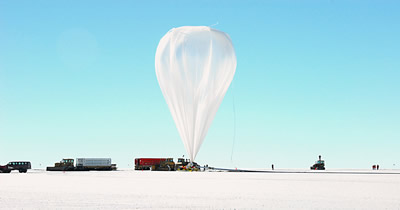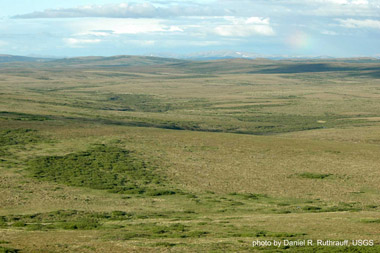The continent of Antarctica in the south polar region of Earth
Click on image for a larger and more detailed map.
NASA
Antarctica
Antarctica is unique. It is the coldest, windiest, and driest continent on Earth. The land is barren and mostly covered with a thick sheet of ice. Antarctica is almost entirely south of the Antarctic Circle (66.5S latitude). It is about one and a half times the size of the United States.
Almost all of Antarctica is covered with a thick ice sheet. Ice shelves extend over the Ross and Weddell Seas. The little bits of land that are not covered by ice are very rocky. In several places under the ice sheet, there are freshwater lakes.
Temperatures can be very low. East Antarctica is colder than West Antarctica because it has a higher elevation. The Antarctic Peninsula has the warmest climate on the continent, however high temperatures still average slightly below freezing.
The tallest mountain of the continent of Antarctica is called Vinson Massif. It is 4897 meters (16,050 feet) above sea level. This mountain formed as faults shifted, sending blocks of the Earth’s crust up to higher elevations. Several of the other mountains in Antarctica are active volcanoes, including those on Deception Island and in remote parts of West Antarctica.
The Antarctic Treaty is an agreement between 45 countries that defines how Antarctica is to be shared as a place for scientific research. According to the treaty, no military from any country is allowed in Antarctica except to help with the scientific research. The treaty was first signed on December 1, 1959.
Last modified January 3, 2007 by Lisa Gardiner.
You might also be interested in:

The United States has dedicated a new scientific station at the geographic South Pole. This is the third station the United States has operated at the South Pole since 1957, and the new station will allow
...more
Scientists from the National Science Foundation (NSF) and the National Aeronautics and Space Administration (NASA) have completed the successful test flight of a new super-pressure (fully sealed) balloon
...more
A team of international scientists has completed an aerial survey of part of the East Antarctic Ice Sheet. The survey was done by the Antarctica Gamburstev Province (AGAP) project with the goal of learning
...more
In the very cold places of the world, survival isn't easy. The soil is frozen, its top surface thawing only during summer, and no trees can grow. Yet plants and animals that are adapted for the harsh
...more
What Will You Find There? South of the Antarctic Circle (at 66.5°S latitude) you will find the continent of Antarctica surrounded by the Southern Ocean, the geographic South Pole and the magnetic South
...more
The Southern Ocean is a bit different. Many mapmakers do not even recognize it as an ocean. The Southern Ocean (sometimes known as the Antarctic Ocean or South Polar Ocean) surrounds Antarctica in the
...more
Ice shelves are a part of the Earth's cryosphere. Ice shelves are usually extensions of glaciers or ice sheets that cover the land. An ice shelf is a part of an ice sheet that extends from land out over
...more














